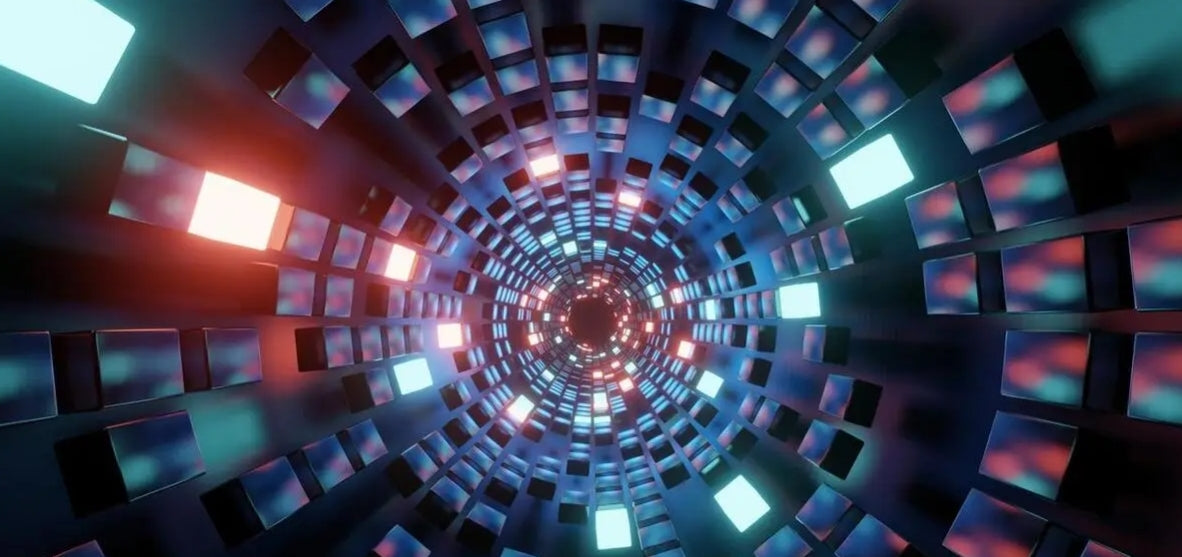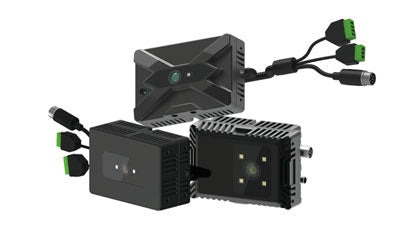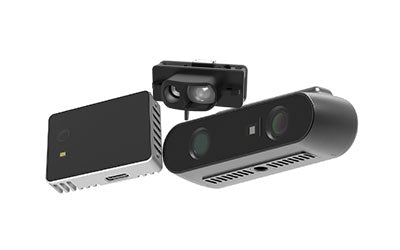TOF + AI Vision: From Traditional Imaging to Intelligent Recognition

mid the ongoing convergence of artificial intelligence and 3D perception, TOF (Time-of-Flight) + AI vision systems are ushering traditional image recognition into a new era of intelligent understanding. Especially in fields such as industrial inspection, smart retail, intelligent security, and autonomous equipment, TOF cameras combined with deep learning models offer a level of three-dimensional comprehension and decision-making that far surpasses conventional 2D cameras, becoming a core component of next-generation intelligent vision solutions.
What is a Time-of-Flight Sensor?
A Time-of-Flight (TOF) sensor is a 3D ranging device that calculates the distance between an object and the sensor by measuring the time it takes for light to travel to the object and reflect back. It can rapidly generate depth images, enabling high-precision spatial and object distance sensing.
Core Features:
-
Non-contact distance measurement, enabling real-time 3D imaging
-
High resistance to ambient light interference, suitable for both indoor and outdoor environments
-
Compact and easy to integrate, widely used in smartphones, robots, drones, and more
Application Scenarios:
Face recognition, volume measurement, fall detection, AR spatial perception, drone obstacle avoidance, etc.
I. The Background of TOF and AI Integration: From 2D Imaging to Spatial Intelligence
Traditional image recognition systems largely rely on 2D images (RGB imagery) for object detection and feature extraction. However, this approach is limited in robustness when applied to real-world environments, often hindered by changes in lighting, occlusion, similar object/background colors, and cluttered scenes—resulting in a significant drop in accuracy. In high-demand scenarios such as industrial inspection, security monitoring, and autonomous driving, where precision and real-time performance are critical, 2D vision alone is no longer sufficient.
With the rapid advancement of 3D vision technology, TOF cameras have emerged as a mainstream choice among 3D sensing devices (3D Depth Cameras / TOF 3D Cameras), playing a pivotal role in replacing conventional RGB-based vision systems. Their working principle involves actively emitting light signals and measuring the time it takes for those signals to reflect back from objects—accurately determining the distance to each pixel in the frame. This Time-of-Flight sensing method offers high accuracy, low latency, and strong anti-interference performance, making it especially suitable for low-light, nighttime, and even completely dark environments.
TOF technology not only allows machines to "see the world," but also to "understand the world." When TOF depth sensors (TOF Sensor / Time of Flight Sensor / TOF Time of Flight) are combined with advanced AI vision algorithms—such as convolutional neural networks (CNNs), pose estimation, and semantic segmentation—they form intelligent perception systems capable of true spatial awareness. Compared with traditional 2D recognition, these systems deliver significantly better performance in complex environments.
For instance, an RGB-D camera (RGBD Camera / RGB-D Camera / RGB D Camera), which fuses RGB imagery with TOF-generated depth maps, can be used not only for object detection, gesture recognition, face recognition, and interactive control, but also for accurate modeling of human posture and behavioral trajectories. This is particularly critical in applications such as smart security, face payment systems, intelligent access control, and service robots.
Moreover, TOF + AI systems can generate real-time 3D point cloud data, enabling high-precision 3D modeling and spatial analysis. They show great potential in 3D vision inspection, volume measurement (Volume Sensors), and building sensor systems (Building Sensors).
Thanks to the development of low-power edge computing chips and model compression technologies, the integration of TOF and AI is no longer limited to high-end platforms. In consumer-grade applications such as gesture-controlled drones (Drone with Gesture Control), obstacle-avoiding smart robots (Drone Object Avoidance / Drone Avoiding Obstacles), and fall detection devices (Fall Sensor), an increasing number of devices are beginning to adopt TOF camera modules (TOF Camera Sensor / TOF Cameras) as replacements for traditional visual or ultrasonic solutions.
The future development path of TOF technology is becoming increasingly clear: smaller modules, longer detection ranges (Long Distance Range Finders), stronger environmental adaptability, and deeper integration with general-purpose AI platforms. Transitioning from 'visual recognition' in 2D to 'spatial cognition' in 3D, TOF + AI vision systems are becoming a critical component of next-generation intelligent perception, driving transformative change across industries—from smart manufacturing to everyday smart living.

II. Advantages of Depth Perception + AI Recognition
As Time-of-Flight (TOF) technology continues to integrate with AI-based computer vision algorithms, intelligent systems built upon TOF sensors (TOF Sensor / TOF Time of Flight Sensor) are showing unprecedented advantages across various industries. Compared to traditional 2D image recognition solutions, TOF+AI systems achieve significant breakthroughs in spatial modeling, recognition accuracy, environmental adaptability, and computational efficiency.
1. Accurate 3D Reconstruction for Real-World Perception
TOF cameras offer real-time 3D imaging, capable of generating high-precision 3D point cloud data (3D Sensing / TOF 3D Sensor) within milliseconds. This enables precise spatial localization and shape reconstruction of every object in a scene. Unlike traditional systems relying solely on RGB images, TOF enables true spatial understanding and 3D modeling (3D Vision Inspection).
This volume sensing capability is particularly critical in areas such as industrial inspection, warehouse management, robotic navigation, and smart manufacturing. For instance, in a packaging factory, a TOF+AI system can identify box volume, shape, and stacking position to automate palletizing and sorting.
2. Strong Robustness and Anti-Interference Capabilities to Overcome Visual Limitations
Traditional RGB cameras often fail in conditions with low light, backlight, occlusion, or complex backgrounds. In contrast, Time-of-Flight Cameras (TOF Cameras / Camera Time of Flight) actively emit light pulses to sense the environment, rather than relying on natural light. This allows TOF systems to provide stable depth data even in low-light or completely dark environments.
As a result, they demonstrate exceptional environmental adaptability in applications like smart security, warehouse surveillance, and indoor drone navigation (Drone Avoiding Obstacles). Especially for night patrols, underground parking recognition, or indoor elderly fall detection, TOF sensors can operate in total darkness—effectively solving the 'can’t see' problem.
Additionally, TOF systems are less sensitive to object color and can provide relatively stable data on reflective surfaces like glass or metal—something that traditional 2D imaging struggles to achieve.
3. Enhanced AI Inference Efficiency for Seamless Edge Deployment
Depth maps generated by TOF drastically reduce the search space for AI algorithms, making it easier and faster to detect objects’ position, size, and posture in images. Compared to traditional visual models, TOF+AI systems interpret image information in a way that is closer to human perception, offering natural spatial semantic support.
This means that high-performance visual recognition can be deployed even on low-power edge devices such as embedded cameras and mobile robots. Examples include:
-
Fall Detectors (Fall Sensor): Detect body posture changes through depth contours and trigger alerts in real-time.
-
Gesture Control Systems (Drone with Gesture Control): Recognize user hand gestures and translate them into command inputs for intuitive interaction.
-
Object Segmentation and Behavior Recognition: Accurately identify specific individuals in a crowd and detect abnormal behaviors (e.g., running, falling, loitering).
-
Object Detection and Path Planning (Drone Object Avoidance): In drone navigation and autonomous driving, TOF provides more accurate obstacle data for dynamic path planning.
By integrating edge AI chips and lightweight neural networks (such as YOLO, MobileNet, EfficientNet), TOF cameras serve as critical sensors in intelligent terminals—achieving stable, efficient AI inference with low power consumption.

III. Typical Application Scenarios of TOF + AI
As Time-of-Flight (ToF) camera technology and AI visual recognition algorithms continue to mature, TOF+AI solutions have been widely implemented across various critical industries—from industrial inspection to consumer electronics, smart retail to intelligent security—serving as a key driver of digital transformation and intelligent automation.
1. Factory Quality Inspection and 3D Vision Inspection
In smart manufacturing environments, product quality control demands high accuracy and efficiency. Traditional 2D image recognition systems often struggle with stacked objects, occlusions, or variations in viewing angles. In contrast, a ToF 3D Camera can generate 3D point cloud maps without relying on structured light or complex calibration, enabling high-speed, non-contact, in-line inspection.
-
Detectable features include: weld position, dimensional deviations, surface dents, edge breakage, etc.
-
Supports dynamic inspection: Paired with high-speed production lines, ToF sensors can acquire data in milliseconds.
-
When combined with AI visual recognition models, these systems can automatically filter defective products and generate inspection reports.
ToF sensors are also widely used in object volume measurement (Volume Sensor), robotic vision alignment, and automated palletizing, forming a complete industrial 3D vision system (Sensor ToF 3D for Industrial Inspection).
2. Retail Face Payment and Foot Traffic Analysis
In the era of smart retail, intelligent visual interaction has become key to enhancing customer experience. Terminals equipped with RGBD Cameras (RGB-D Camera / RGBD Vision Systems) can capture both facial and body depth information as customers enter a store, enabling:
-
Accurate facial recognition and payment verification: Even when customers are wearing masks or in complex lighting conditions, TOF+AI systems maintain high recognition accuracy, improving payment convenience and security.
-
Foot traffic and heat map analysis: With 3D depth sensing, systems can calculate visitor numbers, dwell time, and popular zones, providing valuable insights for store operations.
-
User behavior analysis and recommendations: By estimating body posture and identifying behavior patterns, the system can push personalized products or advertisements to customers.
These systems are also compatible with shared control scenarios, such as self-checkout kiosks or interactive fitting mirrors in shopping malls, creating a more human-centered shopping experience.
3. Intelligent Security and Intrusion Detection
Traditional infrared or 2D visible light cameras often encounter blind spots at night or in complex environments. Security systems equipped with Time-of-Flight Sensors (ToF Time-of-Flight Sensor) can model spatial structures in real time, effectively tracking human movements, behavior patterns, and potential threats.
Advantages of this application include:
-
Fall detection (Fall Sensor): Real-time analysis of human posture to determine if an elderly person has fallen, triggering an alert if needed.
-
Intrusion detection and behavior recognition: Accurately monitors abnormal behaviors such as fence climbing, loitering, or running.
-
Strong adaptability to night-time environments: Compared to inexpensive thermal imaging cameras (Cheap Heat Camera / Inexpensive Thermal Imaging), ToF offers clearer and more stable results, making it ideal for high-security areas like banks, hospitals, and elder care facilities.
Moreover, ToF security systems do not rely on lighting or sensitive color features, helping to protect personal privacy—aligning with modern GDPR privacy compliance requirements.
4. Drone Obstacle Avoidance and Navigation
In autonomous vehicles, drones, service robots, and other mobile devices, obstacle avoidance is a core technology for safe operation. Although traditional ultrasonic sensors or LiDAR provide certain distance detection capabilities, their accuracy and integration level are limited in complex environments.
TOF+AI systems, through ToF Camera Sensors / Time-of-Flight Sensors, offer unmanned devices:
-
Real-time depth perception: Detecting the shape, size, and distance of obstacles ahead for precise avoidance;
-
Collaboration with SLAM algorithms: Integrating positional information to support dynamic path planning and spatial localization;
-
Lightweight and low-power design: Suitable for edge computing platforms such as small drones and robotic vacuum cleaners;
-
Gesture control recognition: Combined with Drone with Gesture Control functions to enable human-machine interaction, command flight, intelligent return, and enhanced user experience.
In the future, with the fusion of Lidar Focusing Systems and ToF RGBD Camera technology, unmanned systems will gain stronger 3D environmental understanding and autonomous decision-making capabilities, accelerating AI autonomous systems’ broad application in security, agriculture, and power inspection.

IV. Challenges Faced by TOF+AI Systems
Despite rapid advances in TOF technology, several challenges remain when integrating with AI vision systems:
-
Computational power limitations: Running deep recognition models on edge devices requires extensive compression and optimization, especially for real-time scenarios;
-
Data fusion complexity: Precise alignment of TOF-generated depth data with RGB images involves YAML configuration and sensor calibration, raising development difficulty;
-
Cost and integration issues: Although TOF modules have become more affordable, they still lag behind cheap distance sensor types in price, limiting large-scale deployment on low-end devices.
V. Outlook: The Fusion Trend of General AI and 3D Sensing
As AI models become more lightweight, general AI systems will gradually integrate TOF 3D sensors (TOF 3D Sensor / Sensor TOF 3D) to upgrade from single-task recognition to multimodal intelligent perception. The future will bring:
-
Long-distance TOF sensors (Long Distance Range Finders) applied in autonomous driving and smart buildings (Building Sensors);
-
Integration of Lidar Focusing Systems with TOF, enabling laser radar functionalities in low-cost solutions;
-
TOF cameras (TOF Kamera) becoming standard visual components for home robots, smart speakers, and security cameras.
Conclusion
The combination of TOF and AI is reshaping how machines perceive the world. From two-dimensional images to three-dimensional understanding, Time-of-Flight Sensing injects 'spatial awareness' into artificial intelligence, expanding the boundaries of intelligent perception. As technology continues to evolve, TOF+AI vision systems will become the foundational pillar of digital transformation across industries, realizing the vision of everything being visible, recognizable, and controllable.
Synexens 3D Of RGBD ToF Depth Sensor_CS30
Our professional technical team specializing in 3D camera ranging is ready to assist you at any time. Whether you encounter any issues with your TOF camera after purchase or need clarification on TOF technology, feel free to contact us anytime. We are committed to providing high-quality technical after-sales service and user experience, ensuring your peace of mind in both shopping and using our products.



